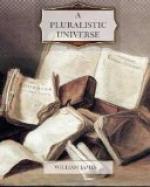The conflict of the two ways of knowing is best summed up in the intellectualist doctrine that ’the same cannot exist in many relations.’ This follows of course from the concepts of the two relations being so distinct that ‘what-is-in-the-one’ means ‘as such’ something distinct from what ‘what-is-in-the-other’ means. It is like Mill’s ironical saying, that we should not think of Newton as both an Englishman and a mathematician, because an Englishman as such is not a mathematician and a mathematician as such is not an Englishman. But the real Newton was somehow both things at once; and throughout the whole finite universe each real thing proves to be many differents without undergoing the necessity of breaking into disconnected editions of itself.
These few indications will perhaps suffice to put you at the bergsonian point of view. The immediate experience of life solves the problems which so baffle our conceptual intelligence: How can what is manifold be one? how can things get out of themselves? how be their own others? how be both distinct and connected? how can they act on one another? how be for others and yet for themselves? how be absent and present at once? The intellect asks these questions much as we might ask how anything can both separate and unite things, or how sounds can grow more alike by continuing to grow more different. If you already know space sensibly, you can answer the former question by pointing to any interval in it, long or short; if you know the musical scale, you can answer the latter by sounding an octave; but then you must first have the sensible knowledge of these realities. Similarly Bergson answers the intellectualist conundrums by pointing back to our various finite sensational experiences and saying, ’Lo, even thus; even so are these other problems solved livingly.’
When you have broken the reality into concepts you never can reconstruct it in its wholeness. Out of no amount of discreteness can you manufacture the concrete. But place yourself at a bound, or d’emblee, as M. Bergson says, inside of the living, moving, active thickness of the real, and all the abstractions and distinctions are given into your hand: you can now make the intellectualist substitutions to your heart’s content. Install yourself in phenomenal movement, for example, and velocity, succession, dates, positions, and innumerable other things are given you in the bargain. But with only an abstract succession of dates and positions you can never patch up movement itself. It slips through their intervals and is lost.
So it is with every concrete thing, however complicated. Our intellectual handling of it is a retrospective patchwork, a post-mortem dissection, and can follow any order we find most expedient. We can make the thing seem self-contradictory whenever we wish to. But place yourself at the point of view of the thing’s interior doing, and all these back-looking and conflicting conceptions lie harmoniously




